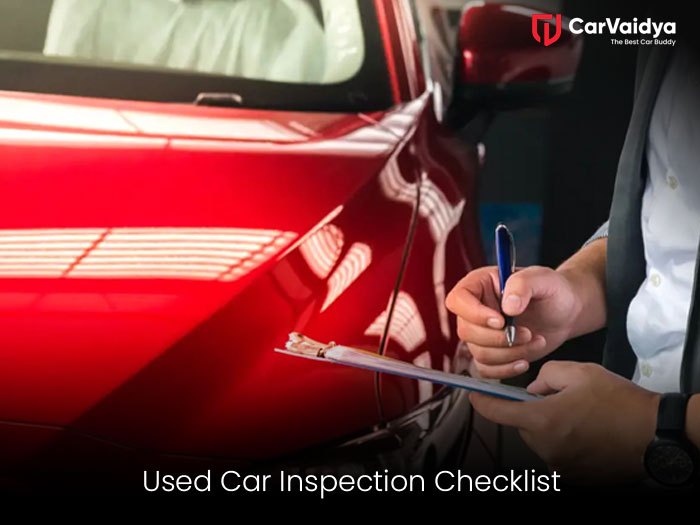How to Inspect an Old Car before Buying


 By CarVaidya
By CarVaidyaBefore buying a used car, it is essential to thoroughly inspect it to identify any issues and understand why it is being sold. We need to delve deep into the reasons for selling the car and carefully check if there are any problems with the car's papers. Additionally, the car itself should be meticulously inspected to ensure there are no hidden issues. CarVaidya will provide you with a full detailed guide on how to inspect a car in this blog.
A used car inspection checklist is a comprehensive guide used by buyers or mechanics to assess the condition of a pre-owned vehicle before purchase. It typically includes items such as checking the exterior for dents or scratches, examining the interior for wear and tear, inspecting the engine for leaks or unusual sounds, testing the functionality of lights and electronics, evaluating the tires for tread wear, and reviewing maintenance records. This checklist ensures that potential issues are identified beforehand, allowing buyers to make informed decisions and negotiate prices accordingly.
Inspecting a used car before buying is essential for several reasons. Firstly, it helps uncover any hidden issues or damages that may not be instantly, probable, established, transparent, and exorbitant buyers from acquiring costly problems. Secondly, it allows buyers to assess the overall condition of the vehicle, including its mechanical entrails, safety features, and general process, to establish, that they're investing in a reliable and safe vehicle. also, a thorough inspection furnish an opportunity to negotiate the price based on any necessary repairs or maintenance. Ultimately, inspecting a used car empowers buyers to make informed decisions and avoid possibly, regrets down the road.
In a used car inspection checklist, focus on the exterior and interior condition, engine health, tire condition, brake performance, suspension, electronics functionality, undercarriage condition, test-drive evaluation, and review of documentation such as maintenance records and vehicle title.
Body Condition: gingerly, check for dents, scratches, and rust.
Glass: inspect, windows and windshield for cracks or chips.
Lights: Ensure all headlights, taillights, and indicators are working properly.
Mirrors: Check the alignment and condition of the mirrors.
Doors and Trunk: Open and close all doors and the trunk to ensure they operate smoothly.
Tires and Wheels: Check the condition of the tires and ensure there is no wheel damage.
Undercarriage: Inspect the car for signs of rust or damage.
Frame: Look for any signs of frame damage or bending.
License Plates and Registration: Ensure that the license number plates and registration papers are up to date and properly attached.
Seats: Check for wear, tear, and proper adjustment.
Dashboard: checked for cracks, damage, and proper service of gauges and indicators.
Controls: Test service of buttons, knobs, and switches for windows, locks, and other features.
Steering Wheel: assure it turns smoothly and there is no enormous, play.
Pedals: Check for wear and tear, and ensure they operate smoothly.
Headliner: Inspect for stains, sagging, or damage.
Floor: Look for signs of water damage, stains, or enormous wear on carpets or floor mats.
Trunk: Check for cleanliness and proper operation of trunk release.
Safety Features: Test seatbelts, airbags, and other safety mechanisms.
Odor: Note any unusual smells, which could indicate mold, mildew, or other issues.
Fluid Levels: Check engine oil, coolant, brake fluid, power steering fluid, and transmission fluid levels.
Leaks: Look for any signs of leaks underneath the engine and around hoses and seals.
Belts and Hoses: Inspect belts for wear and cracks, and hoses for leaks or bulges.
Battery: Check battery terminals for corrosion and ensure it's securely mounted.
Engine Bay: Look for signs of damage, rust, or unusual smells.
Exhaust System: Inspect for rust, holes, or damage to the exhaust pipes and muffler.
Air Filter: Check the condition of the air filter and replace if necessary.
Engine Mounts: Inspect engine mounts for wear or damage.
Fluid Quality: Assess the quality of fluids for cleanliness and proper condition.
Engine Performance: Start the engine and listen for any unusual noises, vibrations, or warning lights on the dashboard.
Start-Up: Ensure the engine starts smoothly and listen for any unusual sounds.
Acceleration: Test acceleration to assess engine power and responsiveness.
Braking: Check brake performance for responsiveness and effectiveness.
Steering: Evaluate steering responsiveness and alignment.
Handling: Assess how the car handles different road conditions, turns, and corners.
Transmission: Test gear shifting for smoothness and responsiveness.
Suspension: Feel for any unusual vibrations or noises over bumps or rough roads.
Noise Level: Listen for any unusual noises from the engine, suspension, or tires.
Electronics: Test functionality of lights, indicators, wipers, air conditioning, and other electronics.
Comfort: Evaluate overall comfort, including seat comfort, noise level, and visibility.
A used car inspection checklist is necessary for buyers and sellers alike. By precisely analyzing a vehicle's condition, buyers ensure transparency, spot issues, and consult a fair price. This guide covers exterior, interior, engine, tire, brake, suspension, electronics, and test drive aspects, facilitating informed decisions and excessive regrets.
6 essential tips to keep your car AC running smoothly during


0 Comments